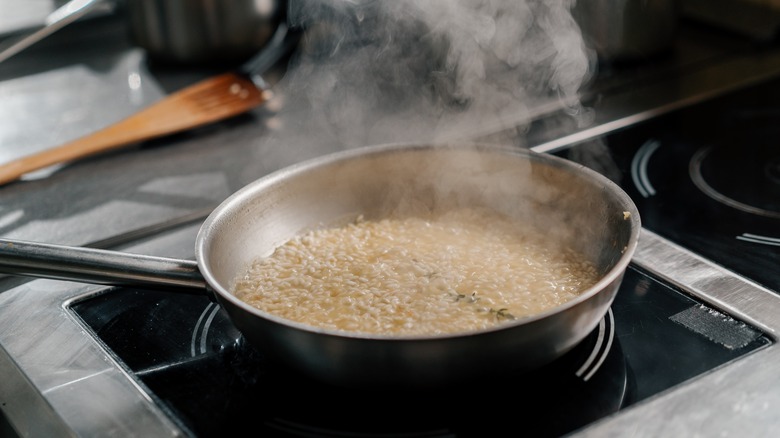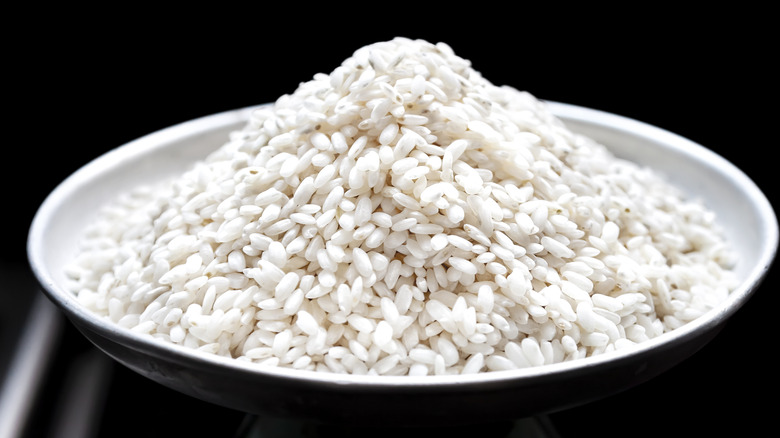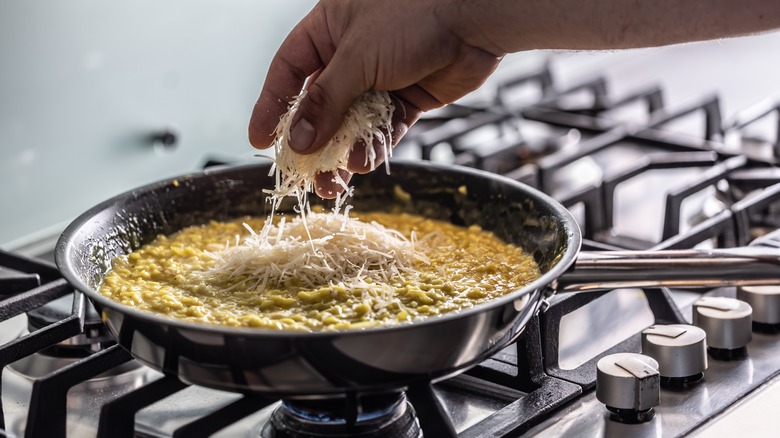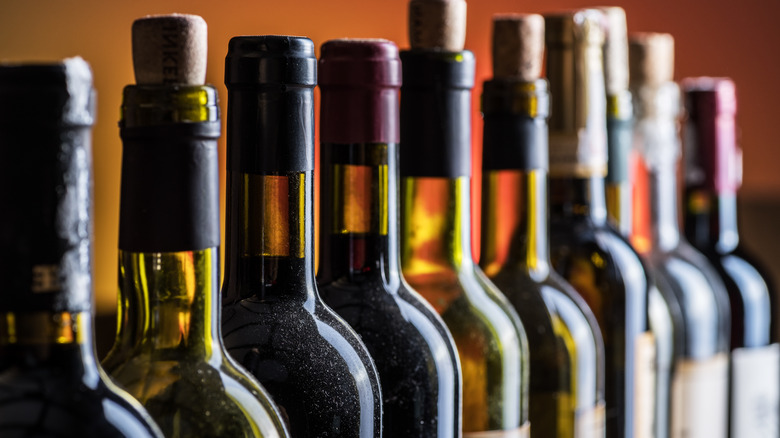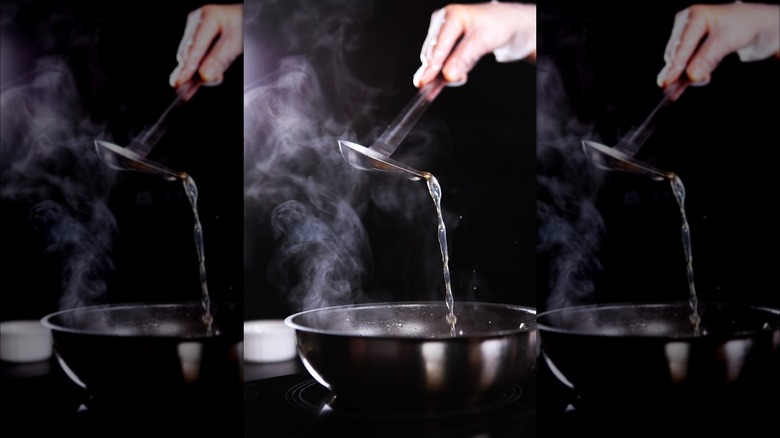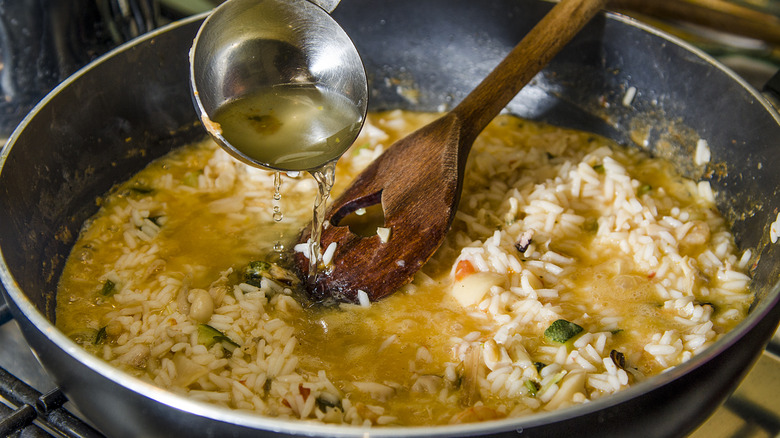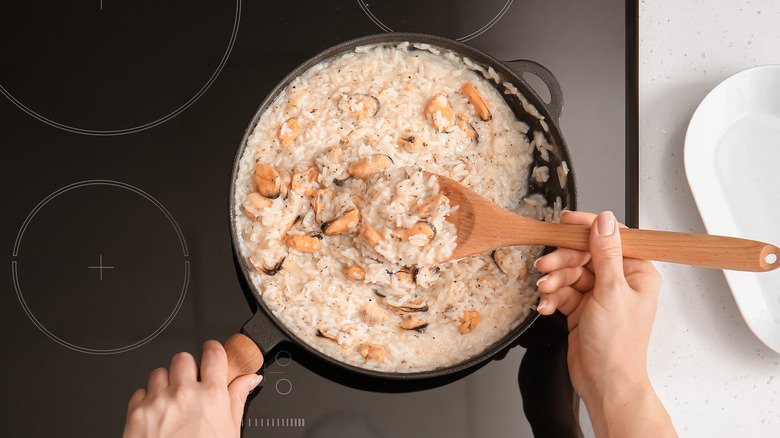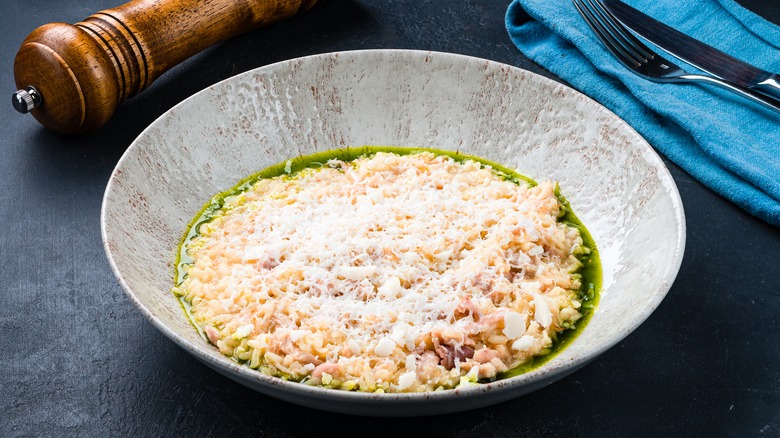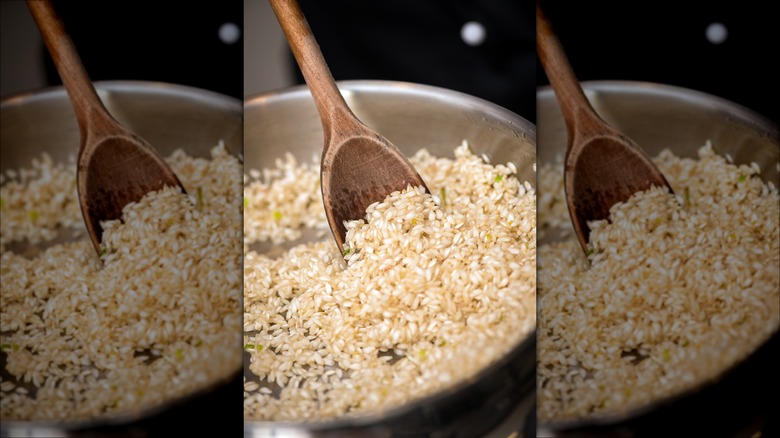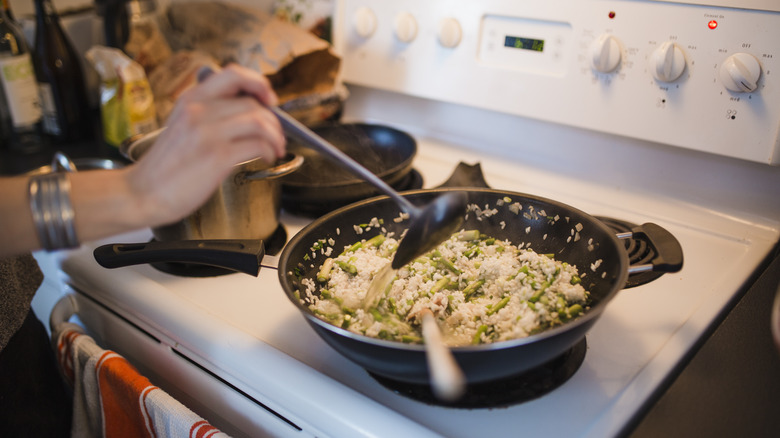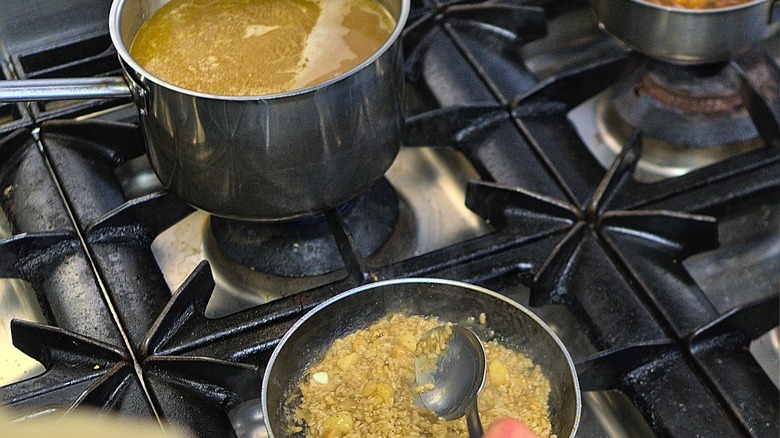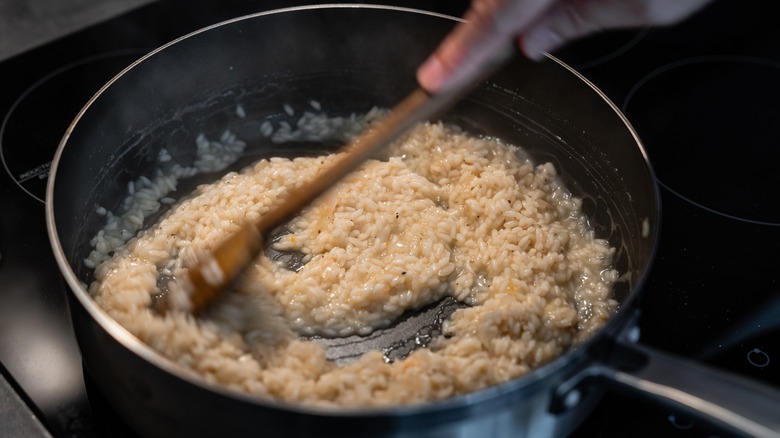12 False Facts About Risotto You Thought Were True, Cleared Up By Chefs
Risotto is often seen as a finicky beast. A wild animal that will turn into a gloopy mess if you look at it wrong. But, there's a lot that people think is true about risotto that's actually false. What if it isn't as ethereal and shrouded in mystery as many folks make out? Maybe it's just a rice dish that needs a bit more attention than others that really isn't all that tricky to get right.
Armed with an Italian grandmother and three experts in Italian cooking, I set out to find the myths and misconceptions about risotto. It's time to sort fact from fiction and stop being as scared of this Italian classic. It's commonly considered hard to make, or, at least, hard to make well. But, actually it's quite a simple dish that just needs a little bit of coddling. People are also full of absolutes about risotto — it must contain dairy, it needs wine, you have to stir it constantly, the broth always has to be added gradually. There might be less truth to these assertions than you've been led to believe.
My experts' opinions will help dispel some of these myths — and might help you make better risotto. It will certainly take some of the stress out of the process, at least. Now, let's explore some of the false facts about risotto you thought were true.
False: Risotto is hard to make
Perhaps the most commonly held opinion about risotto is that it's hard to make. It's one of those dishes that people approach with trepidation. I'm half Italian and even I believed I couldn't make a good risotto until relatively recently. But, it's not true that this dish is hard to make, and this false assumption is standing in your way.
"Risotto is absolutely not hard to master," says principal Collin Pierson of Gene & Georgetti. He notes that really, it just takes a little time and some practice to learn how to do it well. "Like any good dish, practice and relying on instincts really help to create a truly spectacular risotto," he adds.
Chef Steve Chiappetti of The Albert agrees that it's not as hard as people think. "Risotto is a basic dish in Italy, passed down by family members who always have unique interpretations of their own," he remarks. I can verify that it's the kind of thing my nonna will whip up for lunch without a second thought. And she's passed down some of her risotto secrets to me. However, Chiappetti concedes that "it requires a lot of attention when making it, which is a little different from the 'set it and forget it' trend." So, while it is simple, it's also a little needy.
False: There's only one correct type of rice for risotto
Many people think there's only one type of rice you should be using for risotto: arborio. While this is a good rice to make the dish with, it's not the only one that works. You certainly can't use any type of rice — some work and others don't — but there are more options than you might think.
"Arborio or carnaroli are the most commonly used, but there are others that people use," Lauren DeSteno, Executive Chef of Ai Fiori tells us. According to Collin Pierson, Gene & Georgetti opts to use aged carnaroli rice. "Chefs love to use carnaroli because the added drying process concentrates the amount of starch in the rice, leading to a creamier risotto." So, it might be good to drag yourself out of that arborio rut. That said, Steve Chiappetti prefers "superfino Arborio rice," so there's not just one chef-approved favorite.
But, these aren't your only options. The parameters for good risotto rice is that they need to be short-to-medium grained and high in starch. The starch is what gives risotto its creamy texture. Vialone nano is another good risotto rice, but it can be hard to find outside of Italy. Some also swear by baldo rice, enjoying its shorter, rounder grains. Cal riso and maratelli are other classic Italian choices but, again, they can be hard to find.
Whichever type you choose, quality matters. "Go for the more expensive imported varieties, they will make all the time and effort put into making your risotto that much more amazing," remarks Pierson.
False: Risotto always has to contain dairy
Think risotto always has to contain dairy? Think again. You can find plenty of great vegan risotto recipes that use oil in place of butter and focus on the starch of the rice to give the dish a creamy consistency. That's not to say that risotto shouldn't contain dairy, it just doesn't have to.
"Traditionally, risotto does contain Parmigiano Reggiano cheese and a little butter, but there are of course ways around that," Collin Pierson tells us. "The starch of the arborio rice will add some creaminess on its own," but there are other options. For instance, you can use vegan butter and Parmesan alternatives — just be sure to use quality ones because some don't taste great and could do your risotto more harm than good.
Some chefs are very much in favor of using dairy in risotto. "In my opinion, I think it's best with dairy," Steve Chiappetti remarks. "The dairy I use is butter and cheese, and they balance out the acidity from the rice and wine that might be used." Ultimately, cheese and butter aren't essential components in risotto but they add to the flavor and texture. You can make a good risotto without them — if you don't eat dairy or don't have them to hand — but it's not the only way to tackle this dish.
False: Risotto always has to contain wine
Risotto frequently contains wine and most people believe that it's a must. The truth is, it's more of an optional addition, like dairy. Some recipes contain wine and others don't. Many people like the depth of flavor it brings, but you can do without it if you don't drink, are cooking for kids, or want to cut down the cost of the dish.
We asked Collin Pierson if risotto always has to contain wine. "While many Italian grandmothers would say yes, absolutely, it doesn't have to," he replies. "Most recipes, including ours here at Gene & Georgetti, do contain wine, but that can be substituted for added stock and a splash of lemon juice to add a little bit of the acid balance the wine brings to the dish."
According to Steve Chiappetti, it's a tricky question. "Some chefs swear that wine is a necessity in making a risotto," he says. "While I don't think it is absolutely necessary in a risotto, acidity is," he adds. Rice contains natural acidity, he tells us, and butter and cheese also bring a tang that can help balance the dish. Other acidic ingredients you might find in some risotto recipes include vinegar (used sparingly), preserved lemons, or tomatoes.
False: You always have to add the broth gradually
Most people believe that risotto needs to be coddled and carefully attended to. You have to add the broth one ladleful at a time and watch it carefully through the whole cooking process. This is certainly one way to make risotto but it's not the only option.
Lauren DeSteno tells us that, although she prefers to add the broth gradually, some people believe you don't have to. "The action of stirring the rice and agitating the starch on the outside of the kernels is what makes it creamy and 'bound' (fats like butter or olive oil and cheese help this as well)," she explains. "So technically as long as you stir the risotto through most of the time you should be ok — it is just much more difficult to monitor and ensure success."
"You can start by adding double the amount of stock [compared to the quantity of rice] or you can add gradually, but the end result needs to be a creamy consistency," says Steve Chiappetti. There are plenty of recipes that use alternative methods to get the same creamy results without adding the stock gradually. For instance, there are baked risotto recipes and Instant Pot risotto recipes.
So, if you don't have the patience to ladle the broth in gradually, you don't have to. That said, it's easier to get great results by adding it slowly. It's the way my nonna does it and it only takes about 15 to 20 minutes of your attention, so it might be worth it.
False: You should make risotto in a saucepan
When it's time to make risotto, you probably get out a saucepan. Or maybe your favorite enameled Dutch oven. After all, it seems to make sense that this would be the pan to use. It has high sides to stop splattering and a large capacity. But it's not the right tool for the job.
"I always use the same kind of wide and deep sauté pan — this allows you to move the rice around and stir without spillage, and it is not as heavy as a Dutch oven," says Collin Pierson. Lauren DeSteno also agrees this is the best type of pan. "The wider and more sauté-like your pan, the faster the liquid will evaporate so that is something to keep in mind," she tells us.
Pans with a larger surface area allow for better evaporation and this is key to achieving the creamiest risotto. It means the broth evaporates at roughly the same rate that the rice cooks. The result is more concentrated starch in the finished dish, which is the main component in its creamy texture. So, the pan you reach for makes way more of a difference than you might imagine.
False: You always have to follow a recipe
You might think you make the perfect risotto by meticulously following a recipe. And sure, you can get good results this way but it's more nebulous than this. Various factors can affect exactly how much stock you need or how long the rice takes to cook so following a recipe to the letter can be to your detriment. You don't really need a recipe to make risotto. It's more of a formula to follow.
I learned to cook good risotto from my nonna — and her instructions are always very vague. Sauté some onion in butter, add the rice, ladle the stock in a little at a time, and it's done when the rice is al dente. Not a measurement or time frame to be had. It can be daunting for some to approach cooking it this way, but with a basic method in your head, it's pretty easy to make risotto.
"First, sweat the onions, add in rice, and note that the rice needs to be gently toasted in the oil," Steve Chiappetti explains. The liquid comes next, whether broth, wine, water, or a combination. "The level of liquid is important because you want to keep the rice at a level of dryness and still enough liquid to absorb to the point of al dente," he tells us. At this point, you might add veggies and protein, already cooked, if necessary. Then you finish it off with butter or oil, and cheese if you're using it.
False: Risotto should be thick
Of all the mistakes people make when cooking risotto, one of the most common is making it too thick. Although it shouldn't be a soup, it's supposed to be looser than you might think. Not making it liquidy enough can lead to a stodgy dish and that's the last thing you want from risotto.
"Many people believe that risotto should hold up in a heaping mound, and that is simply not true," says Collin Pierson. This kind of texture is common but it's not the Italian way. It shouldn't be watery or thin, but it should be creamy and almost saucy. Not just one stodgy mass of rice. "Risotto should be all'onda — which means 'like a wave'" in Italian, Pierson explains. "It should be flowing, and moving on the plate, not thick or stiff."
That's why you should use the amount of liquid in a risotto recipe as a guide, not an absolute. You might need to add more than stated to get the correct consistency. Alternatively, you may not need all the liquid in a recipe. You might find the rice cooked perfectly with the correct consistency before all the stock is used up — and that's okay.
False: You can add the stock directly after the rice
You're making risotto. You've cooked your onion so it's time to add rice to the pan. You might think that you should instantly start adding the stock, but this isn't the way to go. There's an extra step before you should add liquid.
As Steve Chiappetti explains, the rice needs to be toasted in the oil or butter. The process of toasting rice helps it to release more starch and therefore gives you creamier results. It generally takes a couple of minutes. You should smell a toasty aroma from the rice, but it shouldn't actually start to brown. Browning the rice — or the onions — is something you should avoid. You shouldn't be stingy with the fat in this step, you want every grain fully coated in butter or oil.
Once the rice is toasted, you can carry on with the rest of the recipe. Most of the time, the next step is adding the broth. Though, if you're using wine, you'll add it and cook it off before it's broth time. You might also add harder veggies that need plenty of cooking at this point, such as small chunks of pumpkin.
False: Risotto is just about the type of rice used
If you think that risotto is just about the type of rice used, you're falling for a common misconception. Simply using risotto rice — such as arborio or carnaroli — doesn't make a dish risotto. While it isn't a complicated dish to make, there is nuance and technique to it. You need to learn its rules and make it carefully. That's what will leave you with an exceptional meal on your plate.
Steve Chiappetti is adamant that risotto is about so much more than just the type of rice you use. "It's about the time, care, and attention you give to its preparation," he says. "It is a dish that requires a lot of patience and love for the process." Sure, you can stick all the ingredients in a pot and simmer them, but you're not going to get the same results as you will if you put some effort into it.
It's still a fairly quick dish to make — excluding prep, it can be done in about 20 minutes. And it isn't startlingly difficult but it does take some attention to detail and hands-on time to make it the traditional way. "When it's made with this kind of intention in mind, you're going to get a far superior result," notes Chiappetti.
False: You don't really need to keep the broth warm for risotto
One of the things that makes risotto a bit fussy to make is that the broth is supposed to be kept warm while you cook the dish. However, many people believe that this is just a myth, that you don't really need to do it. Sadly for those looking to make a minimum-effort dish, the idea that keeping the broth warm is a myth is actually a myth in itself. You technically can use cold broth to make risotto but the results are so much better when you keep it warm.
When you add cool or cold broth to risotto, each ladleful drops the temperature of the dish, which interrupts its cooking. It particularly slows cooking in the area you pour the broth onto. This can lead to uneven results, with some grains of rice cooking slower than others.
It might seem like a huge faff to keep broth warm, but it's really not that hard. Put it in a saucepan on the stove next to the skillet you're cooking your risotto in. Keep the burner on low and it will lightly simmer away, holding its heat until you're ready for the next ladleful.
False: Risotto needs constant stirring
It's a common misconception that from the moment you add broth to your risotto, you need to stir it constantly — arm cramps be damned. But, what if you don't need to stir so vigorously? Is it time to give your wooden spoon a break?
Now, we're not saying that you don't need to stir risotto at all. This is part of what helps the starch release, giving the dish its characteristic creamy texture. According to Steve Chiappetti, "stirring is essential" and part of the reason for stirring is to "emulsify the stock with the fats (olive oil, butter, and cheese) and the acid from the wine and rice by incorporating air."
However, it doesn't need to be constant. Some chefs say you can stir it as little as three or four times through the whole process. Others stir it more regularly, but just once every minute or two — or when they feel it needs stirring. There's really no need to stand over the pan and constantly stir. This may even be detrimental to the dish by breaking some of the rice grains. If you're worried about the rice sticking, using a nonstick pan is an option.

